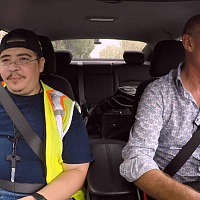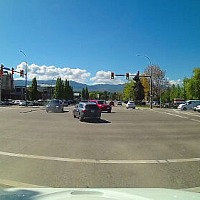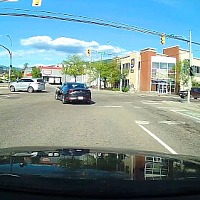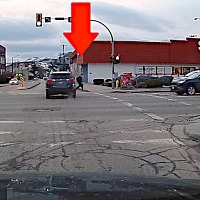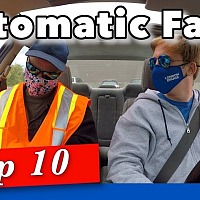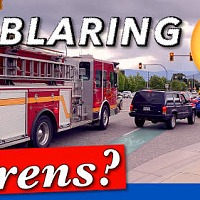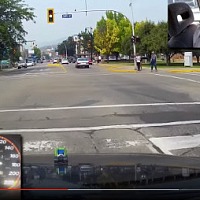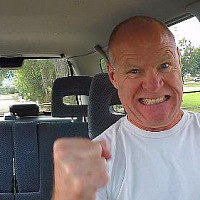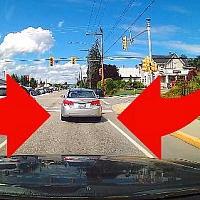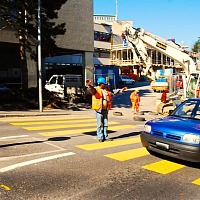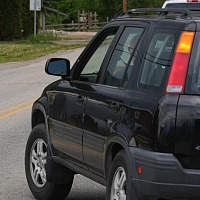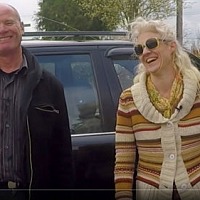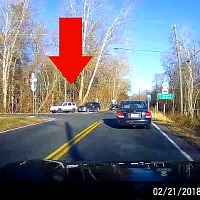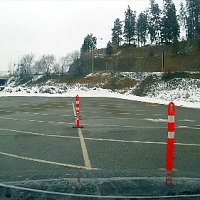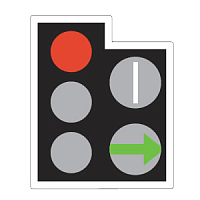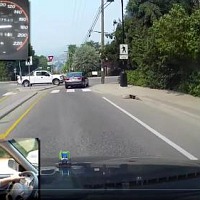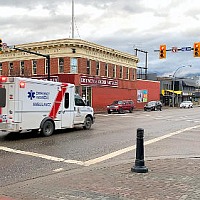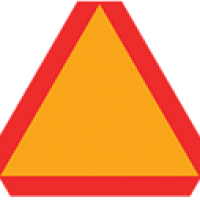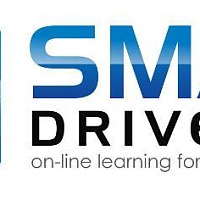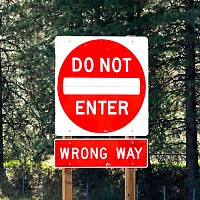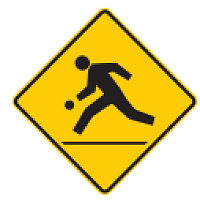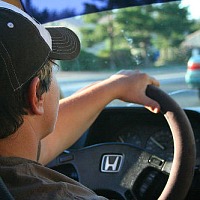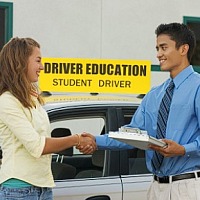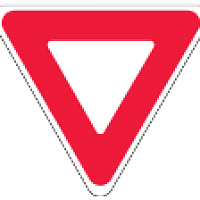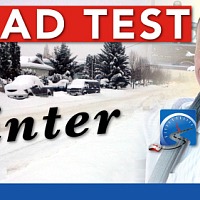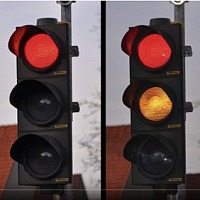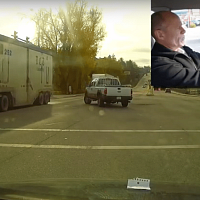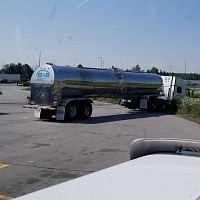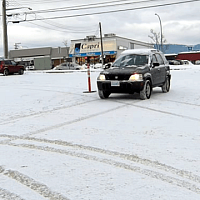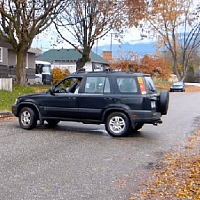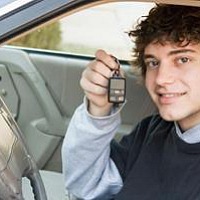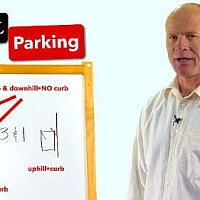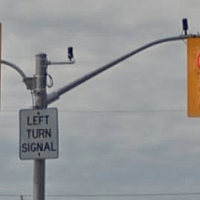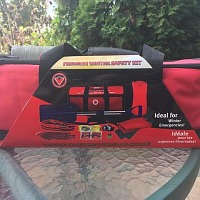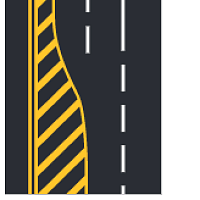Turning left is a complex manoeuvre that often proves daunting for new drivers.
Watch the video to learn the steps.
Closed Captions
Introduction
Hi there smart drivers, Rick with Smart Drive Test talking to you today about left-hand turns.
We're going to give you the theory behind left-hand turns; in other words, we're going to give you step-by-step instructions of how to do left-hand turns.
The steps for doing left-hand turns can be somewhat complicated and overwhelming, especially for new drivers who find it a bit intimidating because you're out there in the intersection and there's lots of traffic applying pressure for you to clear that intersection and not hold up other vehicles and road users.
So when you come up to the intersection, it is imperative that you scan well, and scan properly.
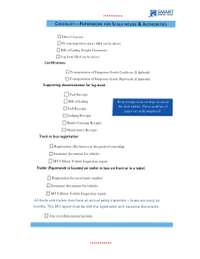 |
Driver's License Checklist• A driving test is a high stress situation. • Authorities demand a high level of skill, ability & knowledge. • Be fully prepared with this checklist!! SIGN UP NOW! |
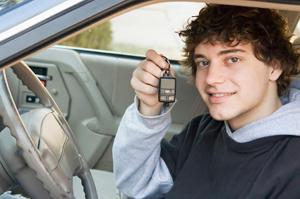 |
And not only do you have to scan forward through the intersection, but you also have to scan the cross- traffic, and look for pedestrians at the cross traffic because if you misjudge the pedestrians they could hold you up in the intersection.
You could find yourself sitting in the middle of the intersection.
And for new drivers they find that incredibly embarrassing.
So today we're going to give you some information about how to do a left-hand turn well, so that you don't end up in that all too embarrassing situation or worse yet, risk a crash.
We'll be right back with that information - stick around.
Locate the Turn
Hi there smart drivers - welcome back.
Rick with Smart Drive Test talking to you today about left-hand turns, giving you step-by-step instructions of how to execute a left-hand turn.
First you need to locate the turn--where you're going to turn--at the intersection and determine if it is legal.
Are there any signs that prohibit you from turning left at that intersection? Oftentimes the signs prohibiting left-hand turns will be over top of the intersection on an overhead sign, and so locate those and determine if you can turn left at that intersection.
Scan, Communicate & Observe
Next thing you want to do, approximately half a block from where you're going to turn, you mirror, signal, shoulder check, and as you're mirror, signal shoulder checking, also check behind you to make sure that there's nobody running up the backend of you.
And that you can slow down without being rear-ended.
Position the Vehicle
The next thing you need to do, is you need to position the vehicle.
And you want to position the vehicle as far left in your lane, but still stay right of the center line.
So you don't want to deviate out of your lane, you just want to move the vehicle over to the left.
So that's my left...that would be your left over there.
So left of your lane - move your vehicle over, position your vehicle.
If it is a controlled intersection, you need to stop at the correct place.
Determine whether it's a yield or whether it's a stop and if it's a stop, you need to stop at the correct position for a STOP signed intersection and I'll put a card up here for you for the video on STOP signs and stopping positions at STOP signed intersections.
If it's a yield, I'll put a card up here for you as well for the yield sign.
And you can find those in the cards in the upper right-hand corner.
Slow to manageable speed
Next thing you need to do if you're coming up here and it is an uncontrolled intersection--there isn't a traffic light, there isn't a stop sign, or a yield sign-- and you're going to proceed left and the way is clear, you need to slow down to 20 to 30 kilometers an hour.
In the United States that would be 12 to 18 miles per hour.
And depending on how big the intersection is, this will determine how fast you can proceed through the intersection.
If it's a busy place or complicated or you have fixed obstacles or other vehicles that are blocking your view of the intersection and the cross street you want to slow down even more - sometimes you might even want to slow down to eight to ten kilometers an hour.
In the United States 5 to 10 miles per hour.
So before you proceed into the intersection, recheck the intersection, recheck the cross traffic, especially over on this side of the intersection.
Recheck the Intersection
You want to make sure there aren't any pedestrians who are going to step out into the roadway or other road users-- people on scooters, and cyclist, and those types of people because if you get into the intersection and they step out there they have the right-of-way and you're going to be stuck in the intersection.
So before you proceed out into the intersection, recheck the intersection - looking for other road users.
As well, any traffic in the intersection--trucks, buses, cars, cyclists, motorcycles--those types of things.
Turn the Vehicle
So thoroughly scan the intersection before you commit to the turn.
Next step is to start turning the vehicle.
On a two-lane road--two lanes that intersect with one another--when the vehicle is at this juncture, [REFERING TO DRAWING ON WHITEBOARD] and you are in line with the edge of the road here, that's when you want to start turning your vehicle, and on subsequent roads-- multi-lane roads that you're turning onto--if there was another lane here--then you would use this center line as you're turning point or just before that centre point.
So if you have a multi-lane, you would bring the vehicle out to here, until you're just before this centre line here - so just here, and then you would start turning.
And you need to turn into this inside lane.
Look in the direction you want to go & steer the vehicle
Now when you start turning and you commit to the turn and are moving through the intersection--you've judged your gap, you make sure that there's no pedestrians on the cross street, you look through the intersection and look in the direction that you want the vehicle to go.
The vehicle will go in the direction that you are looking, so therefore if you're on a multi-lane or your' on two lane, look in the direction you want to go and steer into that lane.
So when you commit to the turn and you've got the position where you're through the intersection on a straight line.
You start to steer the vehicle into the direction you want to go, look in the direction you want to go, come through here, recover the steering wheel.
So bring the steering wheel back-- simply open your fingers, and allow the steering wheel to move you through your hands.
When it comes back to stop, close your fingers.
You may need to recover a little bit to get the vehicle going in the direction that you want to go.
Look in direction you want to go
Look up in the direction you want to go and steer the vehicle in the path of travel, and accelerate back to road speed as quickly as possible.
Always get the vehicle back up to speed as quickly as possible and I'll put a card up here for you on roads speeds.
And you accelerate with your left foot in the path of travel.
Now if you're on a multi-lane, like this [POINTING TO WHITEBOARD DRAWING] and you pull into the left lane ,if you're NOT going to turn left again for some time, make sure you signal right and merge back over to the right-hand lane.
Because for the purposes of a road test, you need to be driving in the right-hand lane.
So those are the steps for making a left-hand turn and the theory behind it and the step-by-step instructions.
Conclusion
So quick review: when you come up to the intersection, locate the intersection, make sure it's legal.
Mirror, signal, shoulder check.
Check the traffic behind you to make sure you can stop without being rear ended.
Scan the intersection thoroughly for other road users.
Approach the intersection - if it's an uncontrolled intersection slow to 20 to 30 kilometers an hour.
In the United States that would be 10 to 15 miles per hour.
Scan the intersection again before you commit - as you move up to the intersection scan again - especially here on the cross streets.
Make sure there's no pedestrians on the cross street.
When you get in line with here, if it's a two-lane road--two two-lane roads that are intersecting--if it's multi-lane, you want to move up to the next one.
When you're in line with the edge of the road, then you start turning.
Look in the path of travel - look where you want the vehicle to go.
Steer through the intersection.
When you get into this lane here, open your fingers, let the steering wheel come back.
When the steering wheel stops, close your fingers.
You may need to correct a little bit.
Look up into the path of travel that you want the vehicle to go and accelerate with your left foot back to road speed as quickly as possible.
If you're on a multi-lane highway, here for example, and you're in the left lane and you're not going to turn left again for some time, make sure that you move back over to the right as quickly as possible.
Question for my smart drivers:
Leave a comment down in the comment section there.
All of that helps us out.
I'm Rick with Smart Drive Test.
Thanks very much for watching.
If you like what you see here share, subscribe, leave a comment down in the comment section.
As well, hit that thumbs up button.
Check out the videos below, check out the cards in the upper right-hand corner - lots of great information for those endeavouring to get their license and pass a road test.
Thanks again for watching.
Good luck on your road test.
And remember, pick the best answer, not necessarily the right answer.
Have a great day.
Bye now!




